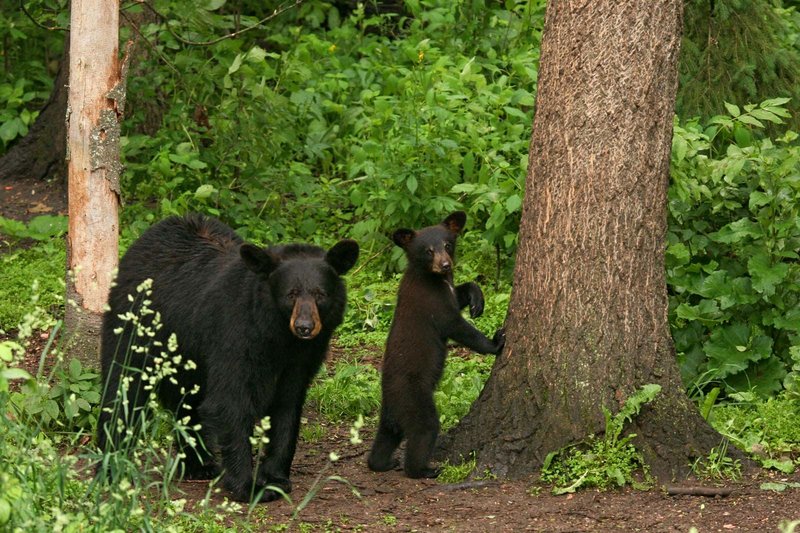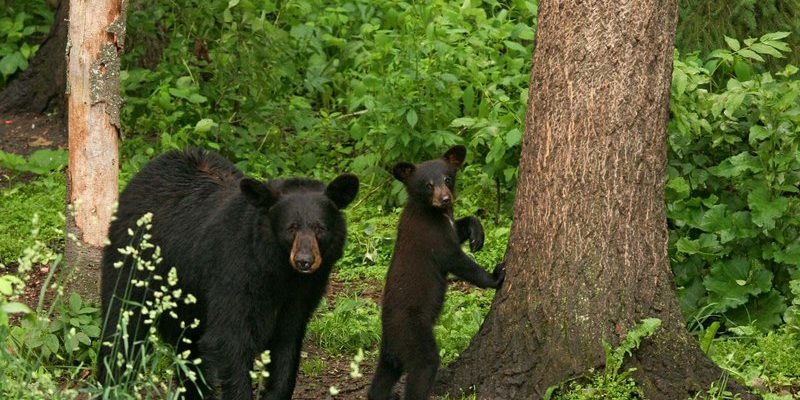
Black bears can be found in North America, living in various habitats from forests to swamps and mountains. You might picture them lounging in the sunshine or rummaging through a pile of leaves, but there’s so much more going on beneath their furry exterior. These intelligent and resourceful animals have developed a range of behaviors and adaptations that allow them to survive and even flourish in harsh environments. Let’s explore the fascinating ways black bears conquer the challenges of their wild homes.
Physical Adaptations for Survival
Black bears have some pretty impressive physical features that help them survive in rugged terrains. Their bodies are built for climbing, running, and digging—all essential skills when food is scarce or predators loom nearby. First off, their strong, muscular limbs equip them for scaling trees, which is crucial for finding food or escaping danger. Did you know black bears are excellent climbers? They can easily ascend a 100-foot tree, which gives them a safe place to rest or snack on tasty fruits.
Another key adaptation is their thick fur. This isn’t just for show! The dense undercoat keeps them warm in freezing temperatures, while the longer guard hairs ward off rain and moisture. During winter, the fur helps insulate their body heat, which is vital since some black bears hibernate in snowy, cold regions. Hibernation is an incredible survival strategy that allows them to conserve energy when food is scarce. Imagine curling up in a warm blanket for months—that’s basically what black bears do!
Lastly, their keen sense of smell is off the charts! Black bears have an extraordinary olfactory system that allows them to detect food from miles away. This means they can find nuts, berries, or even carrion, which becomes essential when their usual food sources dwindle. With those powerful noses, they can sniff out hidden treasures in the wild and secure their meals.
Behavioral Strategies for Finding Food
When it comes to finding food, black bears are remarkably opportunistic. They’re not picky eaters, which is a significant advantage in harsh environments where food can be limited. Their diet can include fruits, nuts, insects, and even small mammals. You might be wondering how they know what to eat. Well, they rely on their instincts, learned behaviors, and seasonal changes.
Bears have incredible memories, especially when it comes to food sources. They’ll remember where they found a big stash of berries last summer and return to that spot the next season. They also take note of which trees produce the best nuts or fruits. This adaptability is crucial for their survival, as it helps them locate food throughout changing seasons, especially in areas with harsh winters.
Additionally, black bears are skilled foragers. They can dig up roots and turn over rocks to uncover hidden insects or grubs. This behavior shows how versatile they are in using their surroundings to find nourishment. Imagine flipping over a rock and discovering a delicious snack underneath—that’s how resourceful these bears can be!
Hibernation: The Ultimate Survival Strategy
Hibernation is one of the most fascinating aspects of a black bear’s survival strategy. When winter rolls in and temperatures drop, food becomes scarce. Instead of staying active and using up valuable energy, black bears enter a state of hibernation, allowing them to survive until spring.
During hibernation, their metabolic rate drops significantly, which means they can live off their fat reserves. This can last for several months, during which time they don’t eat, drink, or even urinate. Their bodies adapt in incredible ways, slowing down heart rates and breathing to conserve energy. It’s like going into sleep mode, allowing them to power down completely until conditions improve.
Finding a cozy den is essential for a successful hibernation. Black bears often choose secluded spots like caves or hollow logs to create their winter home. They’ll line the inside of the den with leaves, fur, and other soft materials, creating a warm, comfortable environment. It’s like curling up in a perfect little nest for the whole winter!
When spring arrives, these bears emerge from their dens, often looking a bit thinner but ready to feast again. This seasonal rhythm is vital for their survival, allowing them to ride out the harshest months of the year with grace.
Adapting to Climate Change
Climate change poses new challenges for wildlife, including black bears. As temperatures rise and weather patterns shift, these animals must adapt to survive. For instance, some areas are experiencing earlier springs, which can disrupt the timing of hibernation. If a bear wakes up too soon, it could miss vital food sources.
Additionally, changes in vegetation affect their food supply. Bears depend heavily on seasonal fruits and nuts, and if these plants don’t bloom or fruit on time, it can create a food shortage. Black bears are facing an uncertain future, and their ability to adapt will be crucial for their survival in these changing environments.
Interestingly, some bears are adjusting their behaviors to cope with these changes. For example, they might change their hibernation patterns or shift their foraging habits depending on what food is available. Scientists are closely studying these adaptations to understand how bears and other wildlife can thrive even as our planet transforms.
Social Behaviors and Survival
While black bears are generally solitary animals, they have intriguing social behaviors that assist in their survival. They communicate using a variety of vocalizations, body language, and scent markings. This communication is especially important during mating season or when a bear feels threatened.
In some cases, mother bears and their cubs showcase impressive social dynamics. A mother bear teaches her young essential skills, from finding food to climbing trees. These lessons are crucial for the cubs’ survival, helping them learn how to navigate their environment effectively. It’s like a crash course in wilderness survival!
Interestingly, black bears have a hierarchy among themselves, especially in areas where food is plentiful. Larger, more dominant bears often have access to the best food sources, while smaller bears may need to be more elusive and clever. Understanding these social behaviors helps bears navigate their challenges and maximize their chances of survival.
The Role of Habitat in Bear Survival
The type of habitat a black bear lives in can significantly impact its survival. Different environments offer various resources and challenges. Forests, mountains, and swamps all come with unique sets of advantages and disadvantages for these animals.
In forested areas, bears can find plenty of food sources like berries and nuts and have ample cover for protection. The trees provide a safe space to climb away from potential predators. Mountain habitats offer similar benefits but come with the added challenge of steep, rocky terrain. Here, bears develop incredible strength and agility to navigate their surroundings.
Swamp environments present their own unique challenges. While they can provide a wealth of food, including fish and vegetation, these areas can be more hazardous due to flooding or fewer safe hiding spots. Black bears learned to adapt by becoming proficient swimmers and foragers, allowing them to thrive even in these challenging habitats.
Black bears are a remarkable example of resilience in harsh environments. Their physical adaptations, clever foraging strategies, hibernation techniques, and social behaviors all contribute to their survival. In a world where challenges seem constant, these bears remind us of the strength of adaptability.
As we continue to face the impacts of climate change, understanding how black bears thrive in their habitats can inform conservation efforts. By learning more about their survival strategies, we can take steps to protect these incredible creatures and the ecosystems they inhabit. After all, every creature has a role in this intricate web of life, and black bears are a vital part of the wilderness tapestry.

